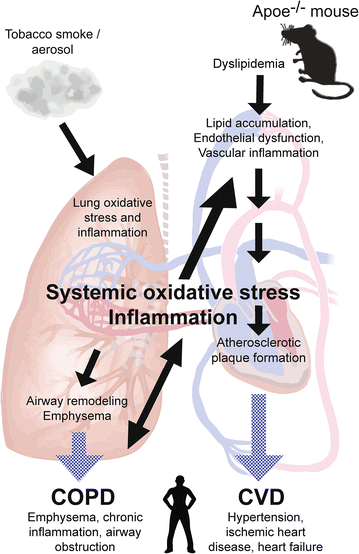The Apoe(-/-) mouse model: a suitable model to study cardiovascular and respiratory diseases in the context of cigarette smoke exposure and harm reduction
- PMID: 27207171
- PMCID: PMC4875735
- DOI: 10.1186/s12967-016-0901-1
The Apoe(-/-) mouse model: a suitable model to study cardiovascular and respiratory diseases in the context of cigarette smoke exposure and harm reduction
Abstract
Atherosclerosis-prone apolipoprotein E-deficient (Apoe(-/-)) mice display poor lipoprotein clearance with subsequent accumulation of cholesterol ester-enriched particles in the blood, which promote the development of atherosclerotic plaques. Therefore, the Apoe(-/-) mouse model is well established for the study of human atherosclerosis. The systemic proinflammatory status of Apoe(-/-) mice also makes them good candidates for studying chronic obstructive pulmonary disease, characterized by pulmonary inflammation, airway obstruction, and emphysema, and which shares several risk factors with cardiovascular diseases, including smoking. Herein, we review the results from published studies using Apoe(-/-) mice, with a particular focus on work conducted in the context of cigarette smoke inhalation studies. The findings from these studies highlight the suitability of this animal model for researching the effects of cigarette smoking on atherosclerosis and emphysema.
Keywords: Apoe; Atherosclerosis; COPD; Cigarette smoke; Emphysema; Lipoprotein; Mouse model; Tobacco heating system.
Figures




References
-
- Libby P, Pasterkamp G. Requiem for the ‘vulnerable plaque’. Eur Heart J. 2015;36:2984–2987. - PubMed
-
- Mozaffarian D, Benjamin EJ, Go AS, Arnett DK, Blaha MJ, Cushman M, de Ferranti S, Despres JP, Fullerton HJ, Howard VJ, et al. Heart disease and stroke statistics–2015 update: a report from the American Heart Association. Circulation. 2015;131:e29–e322. doi: 10.1161/CIR.0000000000000152. - DOI - PubMed
Publication types
MeSH terms
Substances
LinkOut - more resources
Full Text Sources
Other Literature Sources
Medical
Miscellaneous

